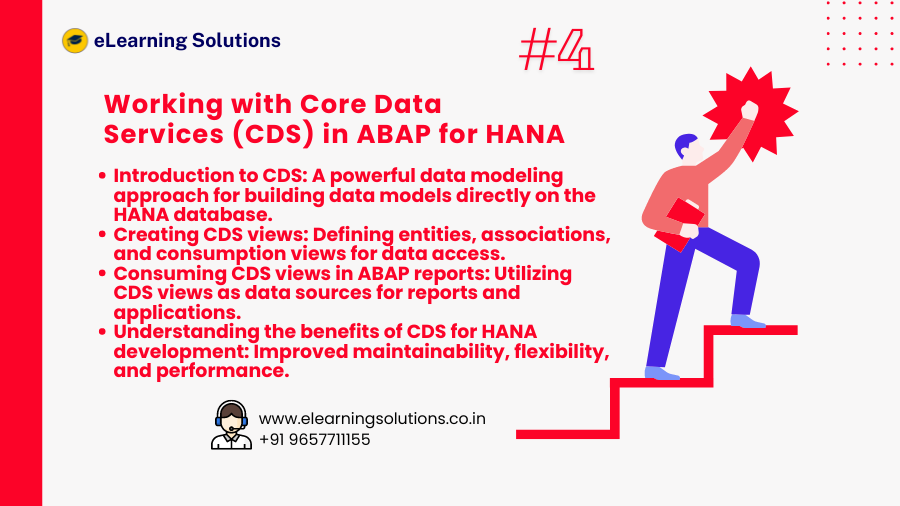Core Data Services in ABAP for HANA: Building Powerful Data Models
In the previous parts of this series, we explored the exciting world of SAP ABAP for HANA. Now, we delve into the specifics of Core Data Services in ABAP for HANA, a revolutionary approach to data modeling that unlocks the full potential of HANA.
Introduction to CDS: A Data Modeling Revolution
Core Data Services (CDS) offers a powerful and elegant way to define data models directly on the HANA database. Unlike traditional data modeling techniques that rely on graphical tools or separate modeling languages, CDS leverages a SQL-based syntax, making it familiar and intuitive for ABAP developers. Here’s what makes CDS stand out:
- Data-Centric Approach: CDS prioritizes the definition of data entities and their relationships, promoting a data-centric development mindset. This ensures your data model accurately reflects the real-world entities and their interactions within your business processes.
- Separation of Concerns: CDS views separate the definition of data (entity view) from its consumption methods (consumption view). This separation of concerns ensures clean and maintainable code. The entity view defines the core structure of your data, while the consumption view specifies how that data is accessed and presented within applications.
- Flexibility: CDS caters to various development scenarios, supporting both analytical and transactional applications. You can create CDS views to serve as data sources for complex reports and analytics, or as a foundation for building transactional applications that interact directly with the data in HANA.
Crafting CDS Views: Building Blocks of Data Access
CDS views are the cornerstone of data modeling in ABAP for HANA. Let’s explore the key components of a CDS view:
- Entities: Represent the core data objects within your model, similar to database tables. Entities are defined using keywords like “define entity” and consist of attributes with specific data types (e.g., string, integer, date). These attributes define the characteristics of your data objects.
- Associations: Establish relationships between entities, allowing you to model complex data hierarchies and connections. Associations are defined using keywords like “define association” and specify the cardinality (one-to-one, one-to-many, etc.) of the relationship. For example, you might define an association between a “Sales Order” entity and an “Order Item” entity, indicating a one-to-many relationship where a single sales order can have multiple order items.
- Consumption Views: Act as gateways for accessing data defined in entity views. These views can be tailored for specific use cases, allowing you to filter, aggregate, and join data as needed. Consumption views provide a controlled mechanism for exposing data to your applications, ensuring they only access the relevant information.
Unleashing the Power: Consuming CDS Views in ABAP Reports
Once your CDS views are defined, you can leverage them as powerful data sources for your ABAP applications. Here’s how:
- ABAP Open SQL: Utilize familiar Open SQL statements to directly query CDS views within your ABAP reports. This approach simplifies data access and promotes code reuse. Since CDS views are built on top of the HANA database, ABAP developers can leverage their existing knowledge of Open SQL to interact with the data model defined in CDS views.
- Annotations: Enhance your CDS views with annotations that provide additional contextual information for ABAP applications. You can define annotations like “semantic key” to specify the unique identifier of an entity. These annotations can improve code readability and maintainability by providing explicit information about the data within the CDS view.
The Advantages of CDS for HANA Development
Integrating CDS into your ABAP for HANA development strategy offers several compelling benefits:
- Improved Maintainability: Data definitions are centralized within CDS views, making maintenance and updates easier. Changes to the data model can be made in a single location, simplifying the update process and reducing the risk of errors.
- Enhanced Flexibility: CDS views cater to diverse needs, allowing you to create both analytical and transactional models. The flexibility of CDS enables you to build a data model that can serve various purposes within your applications.
- Optimized Performance: HANA leverages its in-memory capabilities to execute CDS queries efficiently, ensuring fast data retrieval. Since CDS views reside directly on the HANA database, they benefit from HANA’s processing power, resulting in faster data access and improved application performance.
- Simplified Development: The SQL-like syntax of CDS minimizes the learning curve for ABAP developers familiar with Open SQL. Developers can leverage their existing knowledge of SQL to create and interact with CDS views, reducing the time needed to learn a new data modeling language.
Conclusion
Core Data Services represent a paradigm shift in data modeling for ABAP for HANA development. By embracing CDS, you can create robust, maintainable, and high-performance applications that unlock the true potential of your HANA database. This concludes our series on SAP ABAP for HANA. We hope this blog series has equipped you with a solid foundation for exploring this exciting development landscape.
Here are some additional resources you might find helpful:
- SAP Help Portal: The official SAP Help Portal offers comprehensive documentation on ABAP for HANA and Core Data Services: https://help.sap.com/docs/SAP_HANA_PLATFORM
- SAP Learning Hub: Explore online courses and learning materials on ABAP for HANA development: https://learninghub.sap.com/
- ABAP Community Forums: Engage with other ABAP developers and get answers to your questions on various community forums.



 WhatsApp us
WhatsApp us